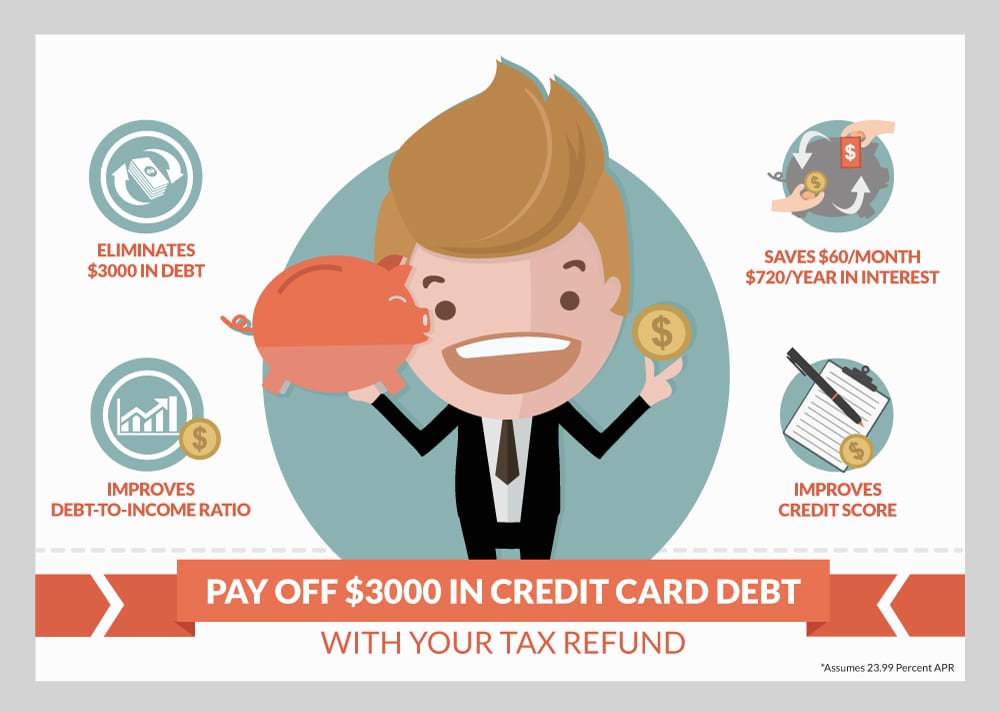It’s tax time. And for most us, this is the only time of year we get a windfall bigger than credit card rewards or grandma’s Christmas check. In fact, the IRS estimates that the average tax refund for 2016 is $2797. That’s nearly $3000.
And the good news from a recent Bankrate.com poll is that only 7 percent of Americans plan on spending their tax refund on a vacation or big-ticket item.
The rest will save, invest or use it to pay off debt.
For those in the pay down debt camp, here’s some advice on how to do it.
Pay Down Credit Card Debt
If you have credit card debt, especially high interest credit card debt, your tax return can make a major dent. In fact, paying down $3000 in credit card debt at 23.99 percent interest will not only eliminate this debt, it will save you $60 a month in interest payments, forever. If you were otherwise going to hold onto this debt for a few years, you’d make back this $3000 in a little over 4 years. Paying down credit card debt with your tax return will also help with your debt-to-income ratio, and potentially, your credit score. It’s a win-win-win-win, as far as we’re concerned.
If you are carrying balances on more than one credit card, you could also consider paying off your smaller balance cards to eliminate payments on them altogether. Paying off small balance cards will accomplish several things: it will pay off the debt owed, save you money on future interest, reduce your monthly debt obligation because you won’t need to make minimum payments on these cards, and bring you closer to becoming debt free.
Start An Emergency Fund
If you don’t have an emergency fund, or you drained yours when your car broke down last, use your tax refund to start one. Ideally, you want 3-6 months worth of expenses socked away in an emergency or “rainy day” fund, to guard against life’s inevitable pitfalls. With an emergency fund in place, you’ll be less likely to use your credit cards or turn to payday loans when the refrigerator dies or your roof starts leaking.
Start Saving
If your emergency fund is in place and credit cards are under control, put your tax return into a savings account that can be used for an upcoming expense, such as a down payment on a car or security deposit on an apartment. Having a robust savings account also comes in handy when you need to unexpectedly replace household appliances like washers, dryers and refrigerators. Finally, a savings account doesn’t just guard you from financial disaster – it helps align you to take advantage of life’s great opportunities, like when your kid qualifies for the national spelling bee (you can go) or prices are slashed on cross-country flights (time to visit the grandchildren?).
Pay Off Your Car Loan
Never lived without a car payment? Give yourself the gift of no car payments. If you are a few months or few thousand dollars away from owning your car outright, consider using your tax refund to pay off your car loan in one lump sum. After paying off your loan, save the money you would be contributing toward your car into a savings account and aim to buy your next vehicle in cash.
Boost Your Retirement Savings: Buy an IRA
If you are credit card debt-free and have adequate savings, consider allocating your tax refund to a retirement account, especially if you are not earning a pension or are contributing to an employer-sponsored 401(k) plan. Opening an IRA (Individual Retirement Account) at a bank or through a brokerage firm like Scottrade, is an easy way to set aside money for retirement that can grow tax-free through your working years.
Using Your Tax Refund Wisely
Are you or your spouse receiving a tax refund this year? Brought to you by Money Minute.
Buy Something That Will Save You Money
Using your tax return to buy something that will save you money month-to-month or over the long-term is also a practical use of your tax refund. Most people pay a premium for their cell phone service because they are paying off a phone that was “given” to them by their provider. Consider skipping the “free” upgrades, buying a phone outright, with cash, and lowering your monthly payment for service to $45 (Verizon Pre-paid service). This can save you $100 or more per month. Most new cell phones can be bought for $500 or less. Sweeten the overall deal by selling your old phone.
Another example would be to upgrade a household appliance to a more energy efficient model. Buying a solar-powered hot water heater will help you save on your monthly bill and will qualify you for tax credits.
Spend Half Your Tax Return
If saving, investing or paying down debt with your whole tax return fills you with dread, make a compromise. Commit to saving half of your tax return. The St. Louis Federal Reserve estimates the US savings rate at 5.5%, or about $2500 per year for a household making $50,000. Saving half of a $3000 tax return is a good start.

4 MINUTE READ
Home » InCharge Blog »
Sources:
- IRS Ready to Start 2016 Tax Season; Encourages use of IRS.gov and e-File; Works with States, Industry on Identity Theft Refund Fraud Retrieved from: https://www.irs.gov/uac/Newsroom/IRS-Ready-to-Start-2016-Tax-Season-Encourages-use-of-IRS-gov-and-e-File-Works-with-States,-Industry-on-Identity-Theft-Refund-Fraud
- Personal Savings Rate. 12/2015. Retrieved from: https://research.stlouisfed.org/fred2/series/PSAVERT
- Steiner, Shayna. How Americans will spend their tax refund. Retrieved from: http://www.bankrate.com/finance/taxes/how-americans-will-spend-their-tax-refund-1.aspx

















